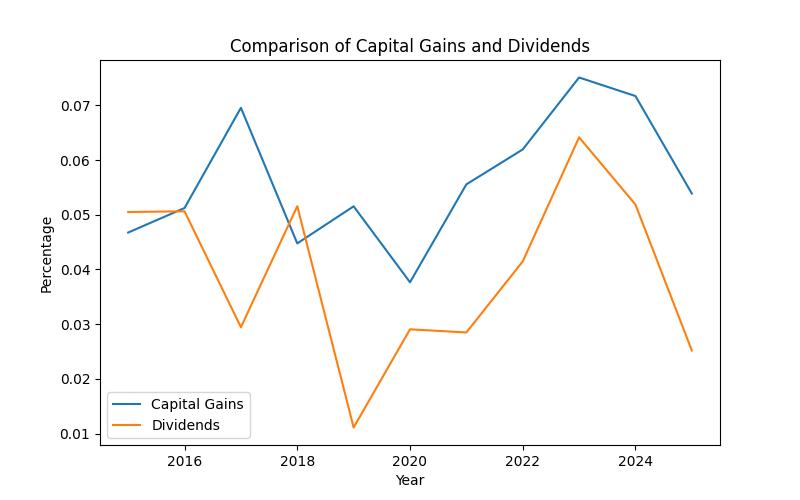The financial landscape is a battlefield where the uninitiated often find themselves lost in a sea of jargon and complex concepts. However, understanding the nuances between capital gains and dividends is crucial for any investor aiming to navigate these waters with confidence.
Far from being interchangeable terms in the investor’s lexicon, these two concepts encapsulate distinct paths to potential wealth and come with their own set of rules, tax implications, and strategic considerations. Let’s dive deep into the heart of the matter, examining each element with a keen eye, and perhaps, dispel some of the fog surrounding these pivotal financial mechanisms.
Understanding Capital Gains and Dividends
By reading this article, you will learn: – The difference between capital gain and dividend. – Distinctions between qualified and nonqualified dividends, and long-term versus short-term capital gains. – How capital losses and capital gains distributions factor into the equation.
Capital Gains and Dividends
At their core, both capital gains and dividends are fruits borne from the tree of investment, yet they ripen under different conditions and offer distinct flavors to savers and investors alike. Capital gains arise from the increase in value of an investment, a testament to the adage of buying low and selling high. Dividends, on the other hand, represent a share of profits distributed to shareholders, a recurring thank you note from companies to their investors.

Key Takeaways
- Capital gains are realized when an investment is sold for more than its purchase price.
- Dividends are the distribution of a portion of a company’s earnings to its shareholders.
- Tax implications for capital gains and dividends significantly differ and can impact an investor’s net return.
- Investment strategies may favor one over the other based on individual financial goals and tax circumstances.
Capital Gains
Long-Term vs. Short-Term Capital Gains
Capital gains are not a monolith but are divided into long-term and short-term gains, each with its distinct tax implications. Long-term gains, accruing from investments held for more than a year, are taxed at a lower rate, reflecting the government’s encouragement of longer-term investment. My personal journey through the maze of investment options has taught me the virtue of patience; holding on to investments not only allows them to potentially increase in value but also offers favorable tax treatment.
Capital Losses
Furthermore, the world of capital gains is not without its pitfalls. Capital losses, the dark twins of capital gains, occur when an investment is sold for less than its purchase price. However, in the realm of silver linings, these losses can offset gains, thereby reducing the tax burden. This strategy, known as tax-loss harvesting, is a critical tool in the savvy investor’s arsenal, demonstrating that sometimes, strategic retreats can lead to more significant victories down the road.
Capital Gains Distributions
Mutual funds and ETFs also partake in the dance of capital gains, distributing them to shareholders. These distributions stem from the fund’s sale of securities in profit, a process often invisible to the individual investor but equally subject to tax. My advice? Keep a close eye on these distributions, especially towards the year’s end, as they can affect your tax obligations.
Dividends
Qualified vs. Nonqualified Dividends
Dividends, like capital gains, come in different flavors: qualified and nonqualified. Qualified dividends, taxed at the lower capital gains rates, must meet specific criteria, including being paid by a U.S. corporation or a qualified foreign corporation and held for a minimum period.
Nonqualified dividends, on the other hand, are taxed as ordinary income, which can be significantly higher. As an investor who cherishes the steady stream of income dividends provide, distinguishing between the two is paramount in optimizing tax efficiency.
Dividend Reinvestment Plans (DRIPs)
One of the most powerful tools in the dividend investor’s toolkit is the Dividend Reinvestment Plan (DRIP). DRIPs allow dividends to be automatically reinvested in purchasing more shares of the company, compounding the investment’s growth over time. This strategy has been a cornerstone of my investment philosophy, transforming modest dividend payouts into significant holdings through the magic of compounding.
The Bottom Line
The debate between capital gains and dividends is not about which is superior but about understanding each’s role in a balanced, strategic approach to investing. Whether you’re swayed by the allure of capital appreciation or the steady promise of dividend income, the key lies in aligning these mechanisms with your financial goals, risk tolerance, and tax situation.
In my journey from a cubicle-bound employee to a liberated investor, I’ve learned that the most potent weapon in the financial arsenal is knowledge. Grasping the differences between capital gains and dividends, leveraging their strengths, and mitigating their weaknesses can turn the tides in the quest for financial independence.
Real-Life Example: Making Smart Investment Choices
I recently had a conversation with my friend Sarah about her investment portfolio. She shared her experience of investing in stocks and how she managed to generate income through capital gains and dividends. Sarah explained that she had purchased some stocks of a well-established company a few years ago and held onto them, allowing the value to increase over time. When she decided to sell the stocks, the profit she made from the sale was considered a long-term capital gain.
Additionally, Sarah also received regular dividend payments from some other stocks she owned. She mentioned that while some of her dividends were classified as qualified, others were nonqualified, and she had to consider the tax implications of each type.
Listening to Sarah’s experience made me realize the importance of understanding the different types of investment income and how they can impact overall returns. It also highlighted the significance of making informed investment decisions to maximize gains while considering tax implications.
Understanding the real-life implications of capital gains and dividends has motivated me to further educate myself on the subject and make smart investment choices for my own financial future.
Frequently Asked Questions (FAQs)
What is the difference between a capital gain and a dividend?
Capital gains occur when an investment is sold for more than its purchase price, while dividends are profits distributed to shareholders. The former is a result of successful speculation or investment growth, and the latter is a share of a company’s earnings.
What is the difference between a qualified and nonqualified dividend?
Qualified dividends meet specific criteria and are taxed at the lower capital gains rates, while nonqualified dividends are taxed as ordinary income, usually at a higher rate.
What is the difference between a long-term and short-term capital gain?
Long-term capital gains arise from investments held for more than one year and are taxed at a lower rate, incentivizing longer-term investment. Short-term capital gains, from investments held for less than a year, are taxed as ordinary income.
What is the difference between a capital gain and a capital gain distribution?
A capital gain is realized when an individual investor sells an investment for a profit. In contrast, a capital gain distribution is a payout made by a mutual fund or ETF from the fund’s sale of securities in profit.
In the arena of finance, knowledge is not just powerit’s profit. Understanding the intricacies of capital gains and dividends is a critical step in crafting a robust investment strategy that navigates the complexities of the market with finesse.
As we journey through the world of investing, let’s remember that the choice between capital gains and dividends is not binary but a harmonious blend that can lead to financial success.
